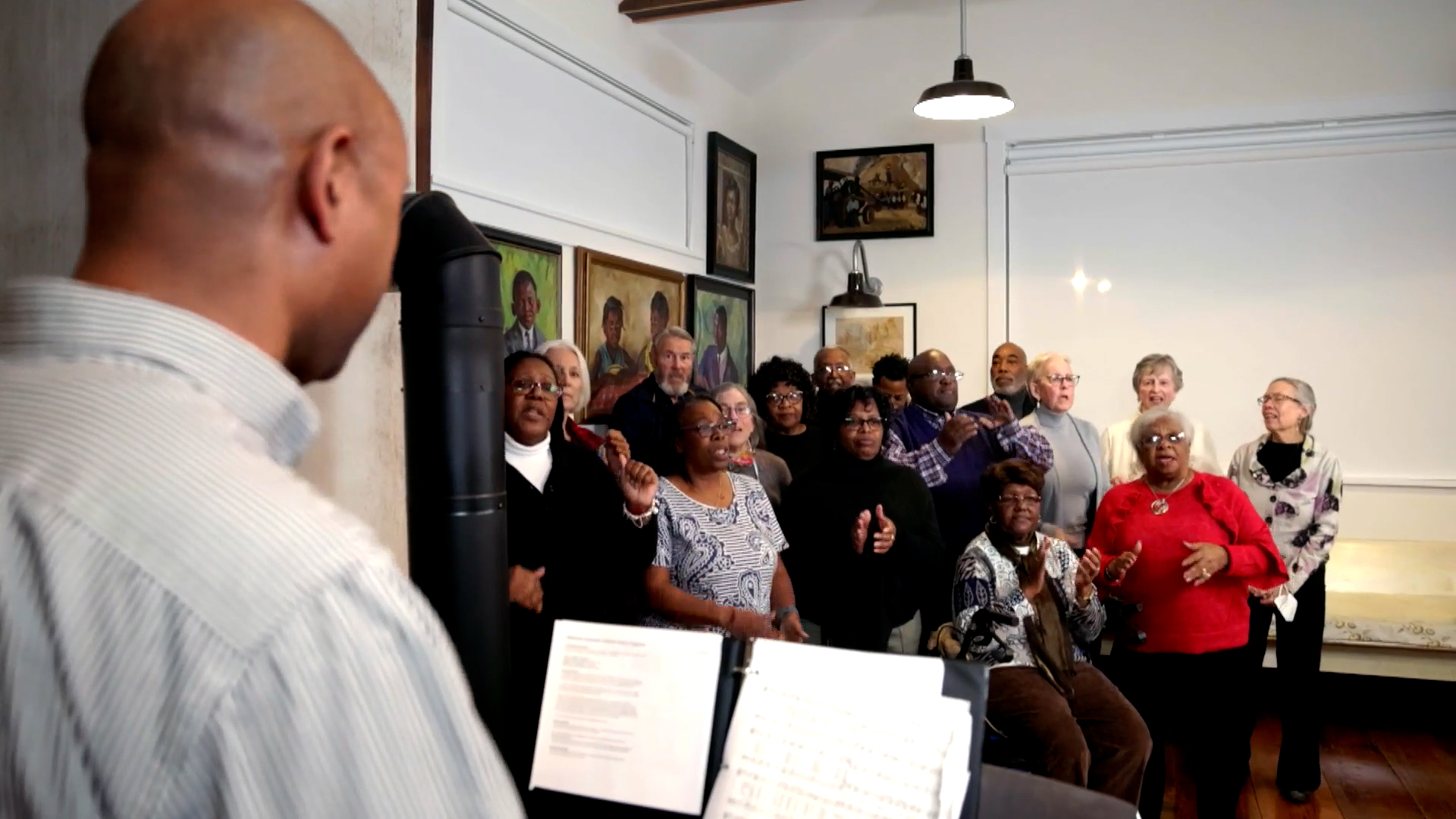
A gospel choir sings in a church in Bellevue, MD
Gospel Music and African American Communities of the Eastern Shore
Grades 3-5
Teacher Resources
In the video clip in this lesson, residents of historic Bellevue, MD introduce themselves and their beloved community. Interspersed in their introductions are clips of a small group performing a gospel rendition of the song “Standing in the Need of Prayer” with piano accompaniment. The key implication is that this musical expression is also an important part of the community’s story.
Procedure
INTRODUCTION (15 minutes)
Read the introduction to students and review new vocabulary. Students will watch the “Water’s Edge: Black Watermen of the Chesapeake” video. After the video, have a discussion around the essential questions and thinking questions aligned to the topic and video.
EXTENSION (15-30 minutes)
Complete extension activities with students, as you see fit.
ASSESSMENT (15 minutes)
Have students apply their newfound knowledge by completing a Summative CER on the lesson using evidence from the video and activities as support.
REFLECTION (10 minutes)
Have students complete a reflection.
Standards
Maryland State Music Standards
- Anchor Standard 10:
Synthesize and relate knowledge and personal experiences to make art.- Exploration
- I:3-5:1: Describe how interests, experiences, knowledge, and skills relate to personal choices and musical intentions when creating, performing, and responding to music.
- E:3-5:1: Identify personal and cultural influences as well as creative preferences in creating, performing, and responding to music.
- E:3-5:2: Identify and document the benefits of, and opportunities for, making music both inside and outside of school and/or music class, including afterschool programs and extracurricular opportunities.
- Anchor Standard 11:
Relate artistic ideas and works with societal, cultural, and historical context to deepen understanding.
- Exploration
- I:3-5:1: Describe and justify how music is a form of personal communication and expression.
- I:3-5:2: Describe and explain factors that impact the role of music in the lives of people.
- Expectations
- E:3-5:2: With limited guidance, connect music to other people’s personal experiences when creating, performing, or responding to music.
- E:3-5:4: Analyze and document how music is used to inform or change beliefs, values, and/or behaviors of an individual or society.
National Association of Music Educators (NAfME) Standards
Common Anchor 10- Connect: Synthesize and relate knowledge and personal experiences to make music.
Common Anchor 11
- Connect: Relate musical ideas and works with varied context to deepen understanding.
Summative CER
Option 1:
Examine the role of gospel music in fostering a sense of community and unity within African American neighborhoods. Support your analysis with examples of personal experiences and community expressions of faith and joy through gospel music. Use evidence and reasoning from the videos and activities to explain your point of view about gospel music and community bonding.
Option 2:
Analyze the historical and cultural significance of gospel music in African American communities. Support your analysis with evidence from both the historical context and the lyrical content of gospel songs using evidence and reasoning from the videos and activities.
Reflection Questions
- How is gospel music different from other types of music that you know?
- What do you think makes gospel music special to African American communities?
- How do the words in gospel songs connect to things that are important to African American communities?
Summative CER Rubric
| No Response Score Point 0 |
Not There Yet Score Point 0.5 |
Beginning To Score Point 0.75 |
Yes Score Point 1.0 |
|---|---|---|---|
| The claim is missing | The claim is incorrect or irrelevant. | The claim partially takes a position on the topic or issue addressed within the prompt. | The claim takes an appropriate position on the topic or issue addressed within the prompt. |
| There is no type of evidence in the response | The evidence is irrelevant or does not support the claim. | The evidence partially supports the claim and demonstrates some understanding of the topic or text, using appropriate sources. | The evidence supports the claim and demonstrates a strong understanding of the topic or text, using appropriate sources. |
| There is no use of words, phrases, and clauses to create cohesion and to clarify the relationship between the claim and evidence. | Use of words, phrases and clauses fail to show or explain any relationship between the claim and evidence. | Words, phrases, and clauses used lack cohesion but partially clarify the relationship between the claim and evidence. | Appropriate words, phrases, and clauses are used to create cohesion and to clarify the relationship between the claim and evidence. |
Teacher Resources
Gospel Music Context
Since its creation, African Americans have incorporated new styles and instrumentation resulting in a number of distinct gospel music expressions (e.g., quartets, choirs, gospel hip hop, praise and worship, etc.).
African American churches and communities were critical to the development and dissemination of gospel music. As such, the music reflects the cultural concepts important to these communities. Group participation is a hallmark of this art form as audience members are often expected to engage with and respond to the presentation. When analyzing gospel music it’s important to pay attention to the physical aspects of the presentation, the distinctive sound qualities used by performers, and the ways in which time, text, and pitch are manipulated (Burnim 2015).
Primary Source Options
While the song "Standin' In the Need of Prayer" (a folk spiritual) has largely been disseminated through oral transmission, over time it has also been transcribed and arranged for inclusion in a number of hymnals.
This version is from the African American Heritage Hymnal (2001).
References
- Maryland Public Television (MPT)
- Burnim, Melonee. 2015. “Gospel.” In African American Music: An Introduction. 2nd ed., edited by Mellonee V. Burnim and Portia K. Maultsby. New York: Routledge.
- Library of Congress , “African American Gospel”
- Maultsby, Portia K. “Gospel Choir”. A History of African American Music. 2021.